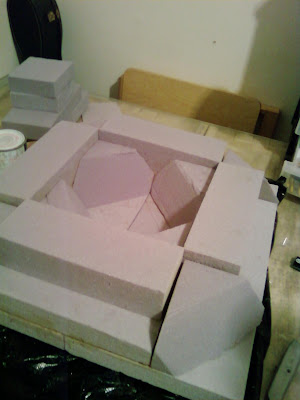so much has happened since we've last spoken. i'll fill you in.
i ended up using the insulator foam spray to fill the holes in the foam, but i got a little carried away and sort of iced the whole thing like a wedding cake.

this stuff really expands and takes a while to set, at least a couple hours, so during this time i started submodeling, carving in details into the crater. At this point i'm not looking to drastically change the shape of the set, so i used the smaller tools available. the clay modeling tools and the pointy device worked well. After the spray dried, I spent some time picking apart the insulation foam because it got too bubbly, as you can see in this picture. I think there are better applications for this material.

I was getting pretty worried reading the warnings on the spray bottles, and I realized that I needed some serious ventilation. This sunday, my good friend
George/Ben Conkin, and my new friend Alex Deschamps came over and helped me tear my room apart. Behold,... THE TOX BOX!

surrounded by trash bags and a plexiglass viewing plate, this is the perfect little fort for adhesive spraying and painting. the worker sits in the gap between the table and works while tourists can watch from the otherside of the glass. it's quite roomy, is it not?

I let alex handle most of the painting this time around while george and i worked on beginning another set. Here are some pictures in the process

for this set, i collected some sand from around the neighborhood to use that has a sort of brown coller and a fine grain. This was applied using the adhesive spray and alex did a good job building it up around where the white foam was to make it blend together. after this, spray paint of various colors were heavily applied. for the base color, spray directly straight on, but to get highlights on the edges, spray from the side.

this is the finished product. Although mistakes were made, I'm fairly happy with it. One thing we learned is that before applying sand grain, or whatever you are using, first put down a layer of acrylic paint directly onto the foam for a stronger color, then do your texture work on top of this. the inside of the crater has acrylic as the bottom layer and i think it somehow looks more convincing.

ultimately, i think we overworked it with the paint and ended up losing some of the nice detail that i carved. live and learn. in terms of our story, it is ok for this set to stand out as a bit different from the rest of our landscape, so i'm glad we did this one first.

did i mention that it has two parts?? just in case we want to get some panning shots on the inside and for easier transport.

this concludes the basic process for building a crater. Big thanks again to alex and george. I will be posting much more about how to make cliffs, valleys and canyons, and hopefully a wrecked space ship.

it's almost like a trip to the zoo!



















































